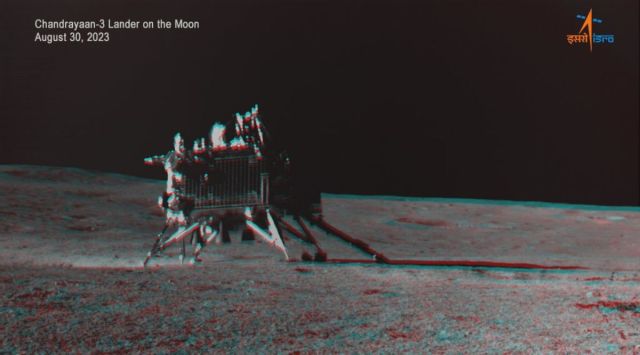ISRO’s Chandrayaan-3 does not wake up as hope dims for Vikram and Pragyan
Hopes are fading for ISRO's Chandrayaan-3 as the mission failed to wake up in the days following sunrise on the Moon.
 To view this image of the Chandrayaan-3 mission in 3D, you will need glasses with different coloured filters over each eye. (ISRO via X.com)
To view this image of the Chandrayaan-3 mission in 3D, you will need glasses with different coloured filters over each eye. (ISRO via X.com) There seems to be little to no hope that the Indian Space Research Organisation’s (ISRO) Chandrayaan-3 mission will wake up again. The space agency was hoping that the Vikram lander and Pragyan rover would wake up when their location was flooded with sunlight as the lunar sunrise happened on September 22. But that was not the case and the chances of it happening grow dimmer as each hour passes by.
After Chandrayaan-3 completed its science objective, ISRO tried to lengthen the lifespan of the mission by shutting down all operations of the instruments before lunar sunset and putting them into “sleep mode.” The mission was designed to function for one lunar day or about 14 days here on Earth. The idea was that the lander and rover might wake up once they got enough sunlight as the sun rose again near the lunar south pole where they are.
The electronics on Vikram and Pragyan are not designed to survive the extreme nighttime conditions on the Moon. During the lunar night, there is absolute darkness due to which the solar-powered mission gets no electricity. Also, temperatures drop well below minus 200 degrees, meaning that the electronics can be frozen and, therefore, destroyed.
But scientists at ISRO were confident that the spacecraft could survive the extreme conditions and reawaken on September 22, reports The Guardian. On that day, the area where the rover and lander are would have been bathed in sunlight, giving them the opportunity to recharge their batteries.
Nonetheless, the space agency has not been able to make contact with the mission and “hopes are dimming.” In fact, there was just a 50-50 chance that the devices could endure the freezing temperatures in the first place.
Former ISRO chief AS Kiran Kumar told BBC that the “chances of reawakening are dimming with each passing hour.” According to Kumar, many of the components may not have survived the extreme conditions on the Moon.
Despite not waking up past its lifetime, the Chandrayaan-3 mission remains an overwhelming success. The primary objective of the mission was to prove India’s ability to soft-land a spacecraft on the Moon. By doing that, India has joined the small list of countries in the world that has ever achieved a lunar soft landing. Other members of the list include the United States, the erstwhile Soviet Union and China.
Also, the Pragyan rover travelled a distance of around 100 metres and detected the presence of several elements on the Moon. Most notably, it picked up evidence of the presence of sulphur, which was never done before by any other mission.







